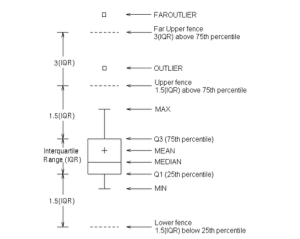SAS Visual Analytics terms
Tools like SAS Visual Analytics and similar use terms like outlier and maximum and I wasn’t sure of the difference.
Today, I was looking at Box plots and while I could see the difference between an outlier and a maximum, I didn’t really know how each is calculated. Here goes….

Source: http://support.sas.com/documentation/cdl/en/grstatgraph/63878/HTML/default/viewer.htm#p0ou4qi2jfcokkn1ks5mx1ct5cmw.htm (November 2014)
While mean, medium and percentile are fairly clear, I’m not sure how the Maximum and outlier are calculated.
SAS defines the maximum and outlier as:
Outlier: an observation outside the lower and upper fences. The fences are located at a distance 1.5 times the Interquartile Range (IQR = Q3 – Q1) above and below the box
Max: maximum data value less than or equal to the upper fence.
Where:
IQR (inter quartile range) = Q3 – Q1
Q1 – 1st quartile (25th percentile). The data must contain a nonmissing value for this quartile.
Q3 – 3rd quartile (75th percentile). The data must contain a nonmissing value for this quartile.
A Course in Data Analytics
I’m doing a part-time course in Data Analytics at the University of Brighton. Seems like a good excuse to post some stuff here and see if my site gets a new lease of life.
I’ll probably post things on here that I need to know.
Plotting data with d3.js and json – Brighton PHP October 2013
This is an example of a plot of the GA (google analytics) data stored in Json format. The data is plotted using d3.js. Have a look at the gallery. I do not think I have done d3js justice with my line charts.
PHP and Fast Fourier Transform – Brighton PHP October 2013
Using data from google analytics (GA) (see other posts) a Fast Fourier Transform is performed on the time series data. The absolute value is saved for plotting using d3.js
Fourier Transforms and Time Series Data
I’m doing a talk at Big Data Brighton on April 25th. I will add the slides after but for now I’ll put up the matlab m file scripts. All at: https://github.com/espeecat/big-data-brighton-april-2013
Slides for Time Series Data and FFT
This shows a single sinusoid and Fourier Transform
This is the example which takes several sinusoids, sums them and shows their Fourier Transforms
This is the filtering example